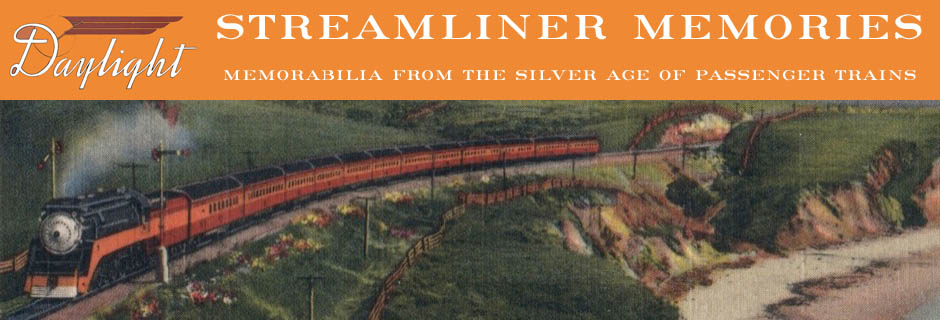By 1949, railroads had bought so many F3s that Trains magazine editor David P. Morgan suggested that railroaders then were “the age of the F3.” He didn’t know that the F7, which would be introduced in 1949, would greatly outsell the F3.

This card is signed by Ben Dedek.
Rather than buy any FT locomotives, Pennsylvania experimented with with turbine-powered locomotives, duplex drives, and other steam innovations. When these had little or no success, PRR jumped on the Diesel bandwagon, buying 120 F3s, more than any other railroad except Union Pacific and Southern Pacific (which also hadn’t bought any FTs). The first four-unit set, numbered 9500-9503, was delivered in July 1947, while the four-unit set shown in the painting was delivered two months later.

I don’t see a signature but this looks like Ben Dedek’s work.
In October 1947 Bangor and Aroostook received the first of its F3s. The railroad ordered four three-unit A-B-A sets.

Ben Dedek’s signature is barely discernible in the lower left corner of the painting on this card.
GM delivered six three-unit F3s to Chicago Great Western in October 1947. Later, CGW purchased six more B units to make them into four-unit sets. In all, it owned 33 A units and 16 B units, including one three-unit set used for passenger service.

No signature is visible on this card.
In October 1947, the Soo Line received the first of five two-unit sets of F3s. Its then-subsidiary Wisconsin Central also bought three three-unit sets.

This poster version of the same painting shows Ben Dedek’s signature in the lower left corner. Dedek was careless to have placed the signature where it would have been cropped out from the data card. Click image for a larger view.
This poster shows more of the painting on which the data card was based. “Poster” is the term used by Greg Palumbo for framable prints of the paintings. I’m not exactly sure how big they are, but they are bigger than the data cards while smaller than the original paintings. Because they are taller (relative to the width) than the data cards they show some features that are cropped out of the cards, such as, this case, the artist’s signature.

This card is signed by Ben Dedek.
Unlike some of the paintings, this one makes clear how Canadian National numbered each of the locomotives in this three-unit set. Rather than number them 9000 A, B, and C, it numbered them 9000, 9001, and 9002. CN only bought two three-unit F3s and they were delivered in May 1948.

This card is signed by Ben Dedek.
The individual units Canadian National subsidiary Grand Trunk Western’s F3 are also separately numbered on this card. The railroad bought eleven two-unit sets whose numbers immediately followed those of CN’s three-unit sets. The first five sets were delivered in May 1948, and the remainder in September 1948.




















